How To Get Rid Of Spider Veins Naturally
Spider veins, also known as telangiectasias, are dilated veins (resembling a spider web) found on the surface of the skin. They usually go undiagnosed unless there are other symptoms associated with their appearance. Spider veins are often associated with throbbing and restless legs, which can get quite bothersome and require attention. This condition is more common among individuals above 50 years of age. However, even young adults can be affected by this condition (1).
In This Article
- What Causes Spider Veins?
- Symptoms Of Spider Veins
- Spider Veins Vs. Varicose Veins
- Who Is At A Risk Of Developing Spider Veins?
- Home Remedies To Improve Spider Veins
- How To Diagnose Spider Veins
- How To Prevent Spider Veins
Back To TOC
What Causes Spider Veins?
Spider veins are common in both men and women. They occur as a result of weakened valves in the veins, which otherwise enable blood flow through the veins. Damaged valves result in the swelling of veins, and these develop into spider veins (2). Some of the most common causes of this condition include:
- Aging
- A family history of spider veins (heredity)
- Professions that require standing for a long time
- Contraceptive pills
- Pregnancy
- Tight clothing
- Increased BMI (Obesity)
- Any prior history of blood clots
- Constipation
Other than being unsightly to look at, spider veins may also be accompanied by a series of symptoms that can become bothersome in the long run (3).
Back To TOC
Symptoms Of Spider Veins
- Itching around the affected area
- Aching legs
- Unusual restlessness in the legs
- Ulcers on the skin
- Rashes around the affected area
- Veins paining on contact
- Changes in the skin around the ankles or calves
But aren't these symptoms similar to that of varicose veins? How are spider veins different? Let's find out below.
Back To TOC
Spider Veins Vs. Varicose Veins
The two most commonly occurring vein conditions are spider veins and varicose veins. Many often get confused between the two types. To help you decide which of the two you are actually suffering from, here are some of major differences between spider veins and varicose veins.
| Spider Veins | Varicose Veins |
|---|---|
| These are tangled groups of blood vessels that occur just below the surface of your skin. | This condition is much more unsightly in appearance than spider veins. |
| They often resemble a spider web or the branches of a tree. | Varicose veins are often bumpy and rope-like in appearance. |
| They may be red, blue, or purple and are often present on the thighs, lower legs, and face. They can also occur on your breasts, ankles, and feet. | Like spider veins, varicose veins can be blue, red or even flesh-colored in some cases. They usually occur in the back of the calves or on the inner legs between the groin and the ankles. |
| They hardly cause any other symptoms. But in some cases, spider veins can cause an itching or burning sensation. | Common symptoms of varicose veins include leg pain, cramps, fatigue, heaviness in the legs, swelling, itching, burning, and even ulcers in severe cases. |
| Spider veins are caused by a medical condition called venous insufficiency. | As in the case of spider veins, the main cause of varicose veins is venous insufficiency. |
The following are the factors that can increase put an individual at a higher risk of developing spider veins.
Back To TOC
Who Is At A Risk Of Developing Spider Veins?
Certain factors can increase your risk of developing spider veins. They include:
- A family history of spider veins or deep vein thrombosis
- Obesity
- Pregnancy
- Standing or sitting for long periods
- Tight clothing
- Smoking
- Exposure to excessive heat
- Gender (Women are at a higher risk than men.)
To treat spider veins and their symptoms at the earliest, it is important to get yourself diagnosed first. How is that done?
Back To TOC
How To Diagnose Spider Veins
Your doctor may perform a physical examination that involves looking at your legs while you are standing to check for any swelling.
You may also need to get an ultrasound test done to check whether your vein valves are functioning normally and if there are any blood clots.
Your doctor can also suggest some treatments to improve the appearance of spider veins. They include:
- Laser therapy – This targets the wider vessels and seals them.
- Surgery to remove the widened vessels.
- Sclerotherapy – It involves injecting a chemical into the inner lining of the blood vessels to cause damage to it.
As spider veins are more of a cosmetic concern than medical, many affected individuals are seen opting for surgery to get rid of their unsightly appearance. However, following some simple and natural remedies, along with a few lifestyle changes, can help deal with this condition without having to go under the knife (4).
Back To TOC
Home Remedies To Improve Spider Veins
- Apple Cider Vinegar
- Witch Hazel
- Massage Oils
- Epsom Salt
- Hot Or Cold Compress
- Grape Seed Extract
- Garlic
- Green Tomatoes
- Ginger
- Ginkgo Biloba
- Horse Chestnut
- Japanese Pagoda Tree Extract
- Lemon Juice And Baking Soda
- Oak Bark Tea
- Alternative Teas
- Tea Tree Oil
- Saline Injection
- Turmeric
1. Apple Cider Vinegar
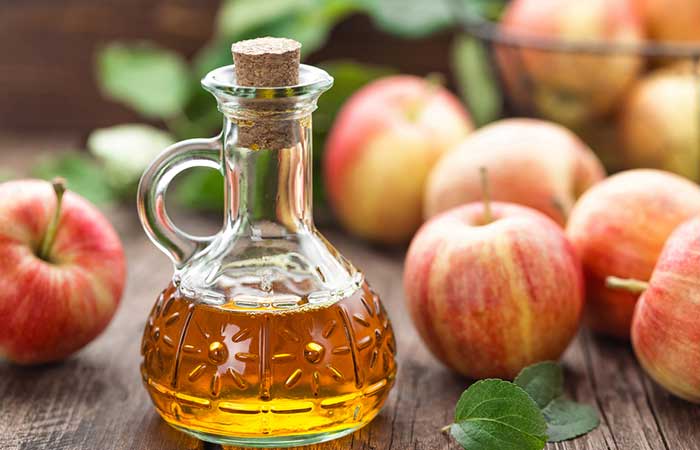
You Will Need
- A clean piece of cloth
- ACV
What You Have To Do
- Take a clean piece of cloth and soak it in ACV.
- Wrap this around the affected areas.
- Leave this on for about 20 to 30 minutes.
How Often You Should Do This
Do this 2 to 3 times daily.
Why This Works
Apple cider vinegar (ACV) improves blood flow in the affected area, thus helping you get rid of spider veins.
Caution
Due to the acidic nature of ACV, it is recommended to do a patch test on your skin before following this remedy.
Back To TOC
2. Witch Hazel
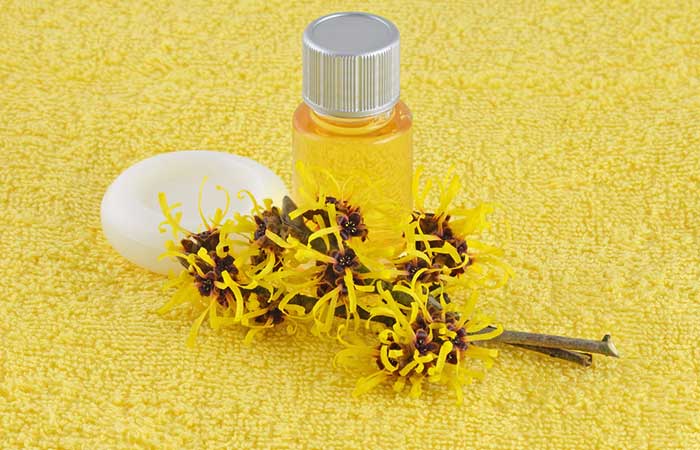
You Will Need
- Cotton pads
- Witch hazel
What You Have To Do
- Take a cotton pad and soak it in witch hazel.
- Dab this directly on the spider veins and leave it on for 20 to 30 minutes.
How Often You Should Do This
Repeat this 2 to 3 times daily.
Why This Works
Witch hazel is a natural astringent and is also known for its anti-inflammatory properties. The spider veins shrink and become less visible on the topical application of this oil. Witch hazel contains tannins and volatile oils, both of which can reduce inflammation and heal the inflamed veins (5).
Back To TOC
3. Massage Oils
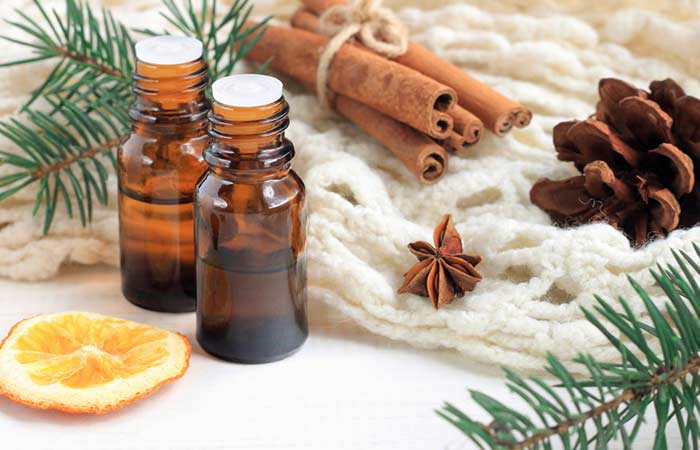
Shutterstock
One of the basic and most efficient ways to treat spider veins is by massaging the affected area. Massaging the affected area improves blood flow and diminishes the appearance of spider veins.
a. Castor Oil
You Will Need
Cold compressed castor oil
What You Have To Do
- Apply cold compressed castor oil directly to the affected areas.
- Leave it on for 20 to 30 minutes.
How Often You Should Do This
Follow this regimen 2 to 3 times daily.
Why This Works
Being anti-inflammatory and stimulating in nature, castor oil improves blood circulation. This property can treat spider veins and reduce their appearance.
Tip
Use cold compressed castor oil as this is its purest form.
b. Coconut Oil
You Will Need
Cold compressed coconut oil
What You Have To Do
- Take some coconut oil and warm it by rubbing it between your hands.
- Massage it onto the affected areas.
- Continue massaging for 10 to 15 minutes.
How Often You Should Do This
Repeat this daily for best results.
Why This Works
Coconut oil is one of the best natural sources of antioxidants. It improves blood flow, thus treating spider veins (6).
Caution
Cold compressed coconut oil is recommended due to its refined composition.
Back To TOC
4. Epsom Salt
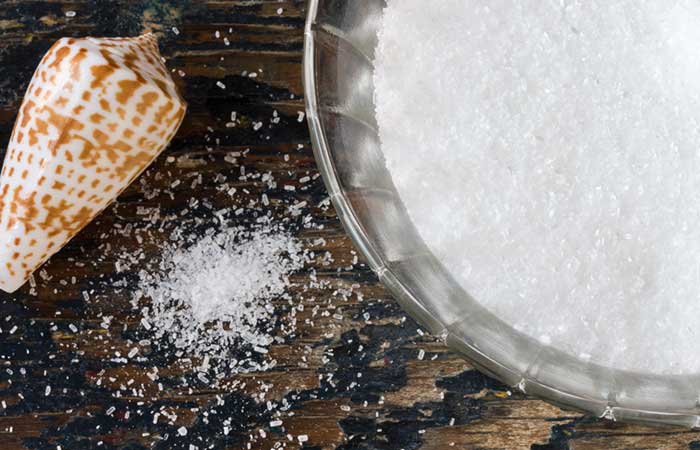
You Will Need
- 2-3 cups of Epsom salt
- Water
What You Have To Do
- Add two to three cups of Epsom salt to your bathwater.
- Soak in it and relax for 30 to 40 minutes.
- Alternatively, you can pour a cup of Epsom salt in a bucket filled with water and use it to soak your legs.
How Often You Should Do This
Do this 3 to 4 times a week.
Why This Works
Epsom salt, also known as magnesium sulfate, is well known for its detoxifying and anti-inflammatory properties (7). The magnesium content in this salt helps to treat the inflamed spider veins and reduces their appearance. However, Epsom salt is to be only used externally and should not be ingested.
Back To TOC
5. Hot Or Cold Compress
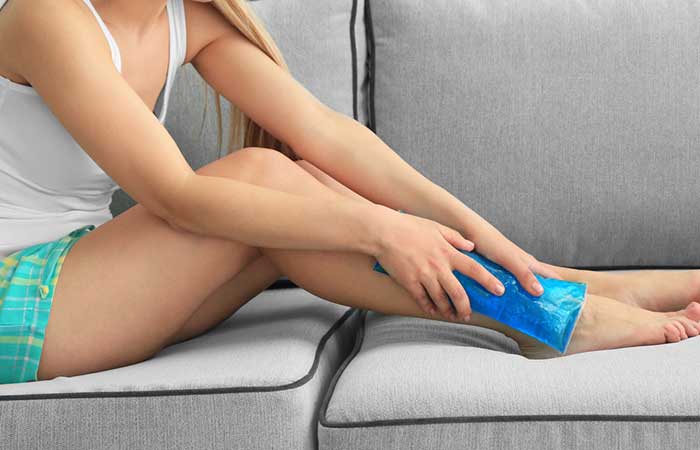
You Will Need
Hot/Cold compress
What You Have To Do
- In case there is a blood clot in any of the spider veins, elevate your leg and use a hot compress on the affected area.
- A cold compress is usually used when there is an injury on the area affected by spider veins.
How Often You Should Do This
Use according to your symptoms.
Why This Works
A hot compress removes clots and promotes blood flow while a cold compress reduces inflammation and minimizes bruising around the spider veins.
Caution
Elevate your leg while applying a compress. This is to avoid pooling of blood in the affected area.
Back To TOC
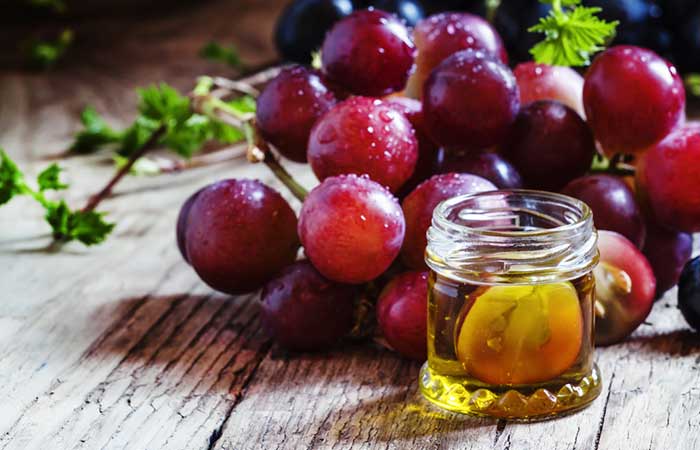
You Will Need
Grape seed extract supplement (liquid or capsule form)
What You Have To Do
Take 720 mg of grape seed extract.
How Often You Should Do This
Consume this supplement daily.
Why This Works
The seeds of black or red grapes are rich in bioflavonoids called oligomeric proanthocyanidin complexes (OPCs) (7). These complexes are known to treat spider veins by promoting the circulation of blood while reducing inflammation.
Back To TOC
7. Garlic
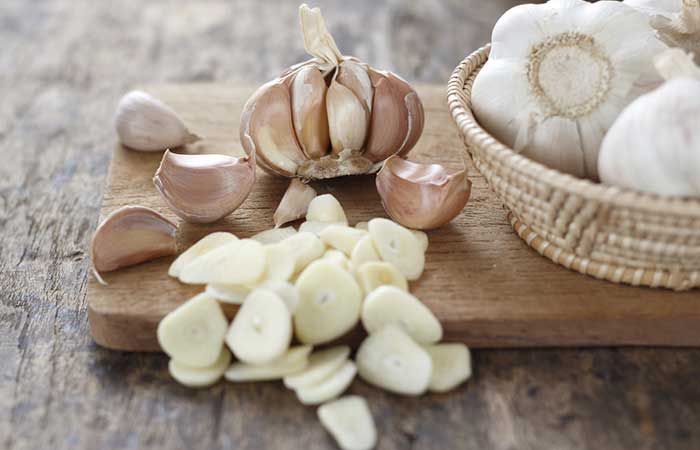
You Will Need
- 6 garlic cloves
- Rubbing alcohol
What You Have To Do
- Take six cloves of garlic and mince them to form a fine paste.
- Mix this paste with a few drops of rubbing alcohol and massage onto the affected area.
- Leave it on for 15 to 20 minutes.
How Often You Should Do This
Repeat this procedure daily for best results.
Why This Works
Garlic is best known for its antioxidant and anti-inflammatory properties. Its ability to enhance blood circulation helps in the treatment of spider veins (8).
For best results, you can also include garlic in your diet.
Back To TOC
8. Green Tomatoes
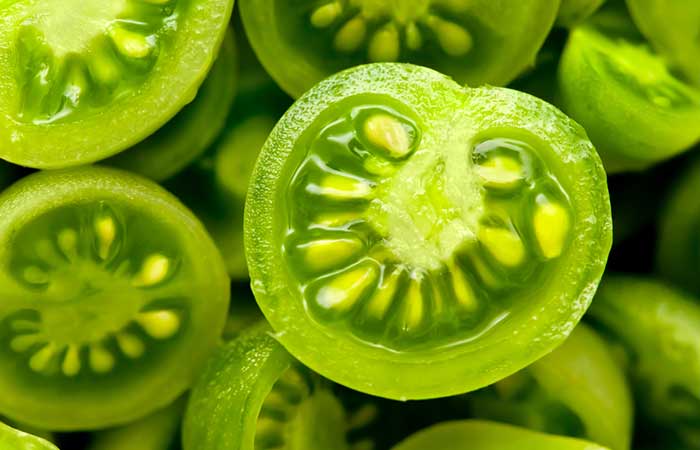
You Will Need
- Green tomatoes
- Bandage
What You Have To Do
- Wash the tomatoes.
- Slice them into rings and place them on the affected areas.
- Wrap the entire area with a bandage.
- Leave it on until you feel a tingling sensation in the covered area.
- Remove the bandage and wash your skin thoroughly with water.
How Often You Should Do This
Do this 4 times a day.
Why This Works
Green tomatoes enhance blood circulation in the affected areas. The seeds of these tomatoes contain an acidic substance that helps in this regard. This substance acts as a natural anticoagulant, helps improve blood flow, and reduces inflammation.
Caution
Do not wrap the bandage too tightly around the spider veins.
Back To TOC
9. Ginger
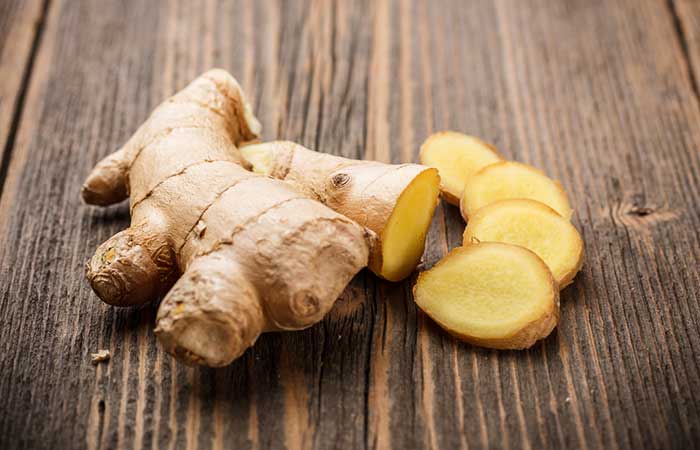
You Will Need
- 1 inch ginger
- Water
What You Have To Do
- Cut the ginger into small pieces and add to a glass of boiling water.
- Let it simmer for 10 minutes.
- Strain the water and add honey to taste.
- Consume this water immediately.
How Often You Should Do This
Do this 2 to 3 times a day.
Why This Works
The anti-inflammatory and antioxidant properties of ginger are due to the presence of a compound called gingerol. These properties make ginger one of the best natural ways to combat spider veins (9).
You can also include ginger in your daily diet.
Back To TOC
10. Ginkgo Biloba

You Will Need
40 mg ginkgo extract supplements
What You Have To Do
Consume 40 mg of ginkgo extract.
How Often You Should Do This
Consume this 3 times a day.
Why This Works
Ginkgo biloba contains active ingredients that are known to strengthen the tissues of the vein walls. It is also used to improve blood circulation, and can thus be used for treating spider veins as well.
Back To TOC
11. Horse Chestnut

You Will Need
Aescin supplement (50mg)
What You Have To Do
Consume 50 mg of aescin supplement on a daily basis.
How Often You Should Do This
Have this twice daily.
Why This Works
Being a flowering plant, horse chestnut contains a component called aescin. This extract strengthens the tissues of the vein walls and reduces inflammation caused by spider veins. It is also involved in the active regeneration of weak or damaged veins (10).
Tip
You can top this with one of the topical remedies.
Back To TOC

You Will Need
Japanese pagoda extract and its supplement
What You Have To Do
You can either take Japanese pagoda tree extract as a supplement or apply it topically.
How Often You Should Do This
Do this daily.
Why This Works
Japanese pagoda extract increases the circulation of blood and strengthens the veins.
Back To TOC
13. Lemon Juice And Baking Soda
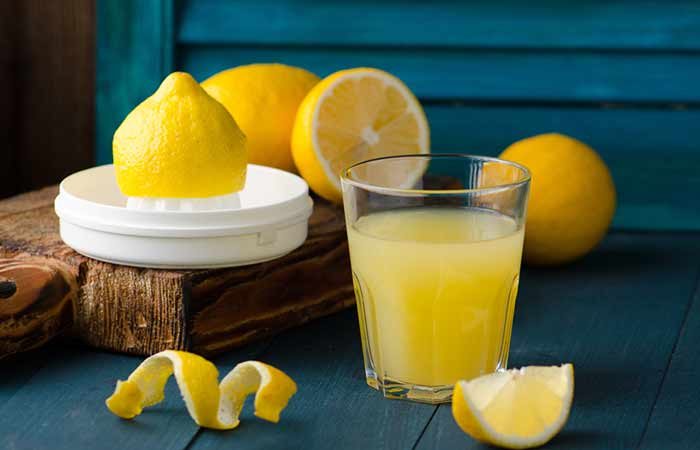
You Will Need
- 1-2 tablespoons of freshly squeezed lemon
- 1/8 teaspoon of baking soda
- 1 glass of water
What You Have To Do
- Add one to two tablespoons of lemon juice to a glass of water.
- Add baking soda to this mixture.
- At this point, the solution becomes fizzy.
- Once the fizz reduces, you can go ahead and consume this solution.
How Often You Should Do This
Drink 2 to 3 glasses of this mixture daily.
Why This Works
Lemon juice is rich in vitamin C and is often used as a blood purifier. Baking soda is alkaline and is often used for its neutralizing properties (11). A combination of these compounds was found to relieve and treat spider veins.
Tip
Alternatively, you can apply lemon topically on the affected areas.
Back To TOC
14. Oak Bark Tea
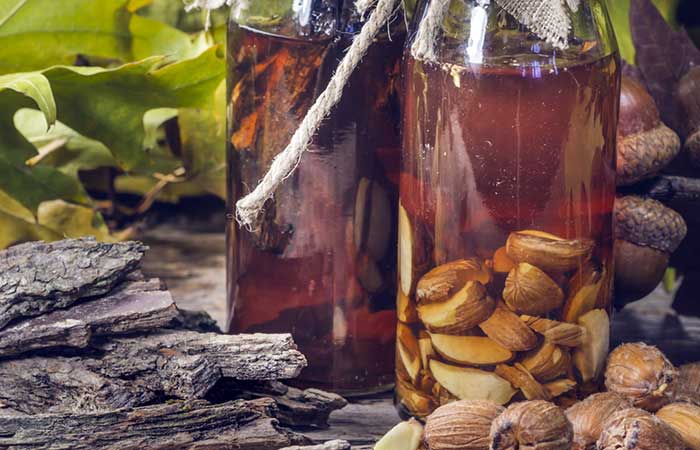
You Will Need
- Oak bark tea extract
- Water
What You Have To Do
- Boil some oak bark tea extract with a cup of water.
- Add honey for flavor. Consume immediately.
How Often You Should Do This
Consume one cup of oak bark tea daily.
Why This Works
Being rich in many vitamins and minerals, white oak bark tea is quite popular for its healing properties. One of its greatest advantages is its ability to stabilize and strengthen veins. Thus, oak bark tea is used in the treatment of spider veins as well.
Tip
You can also apply this tea topically with a cloth compress. Once absorbed by the skin, it can relieve symptoms associated with spider veins.
Back To TOC
15. Alternative Teas
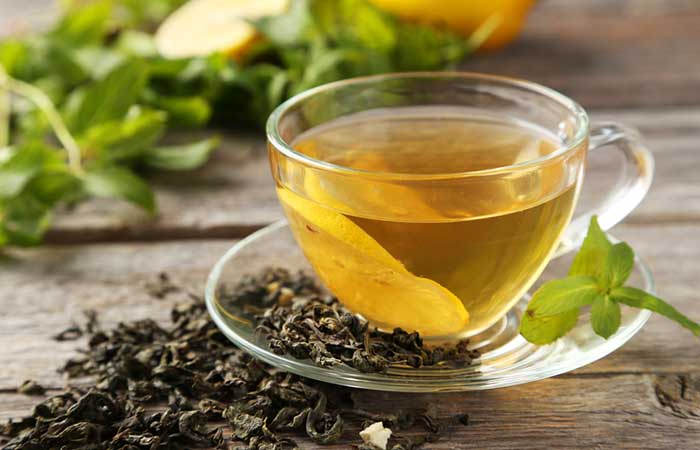
a. Green Tea
You Will Need
- Green tea extract
- Water
What You Have To Do
- Boil some green tea extract with a cup of water.
- Add honey for flavor. Consume immediately.
How Often You Should Do This
Drink 2 cups of green tea daily.
Why This Works
Green tea is one of the best natural antioxidants. This property makes it suitable to treat a variety of ailments, including spider veins. It can reduce inflammation and strengthen the vein walls (11).
b. Chamomile Tea
You Will Need
- Chamomile tea extract
- Water
What You Have To Do
- Boil some chamomile tea extract with a cup of water.
- Add honey for flavor. Consume immediately.
How Often You Should Do This
Drink chamomile tea daily for best results.
Why This Works
Chamomile tea has antiseptic and anti-inflammatory properties that can help treat spider veins and their symptoms (12).
Tip
Chamomile tea can also be soaked in a cloth and wrapped around the spider veins for faster recovery.
c. Witch Hazel
You Will Need
- Witch hazel tea extract
- Water
What You Have To Do
- Boil some witch hazel tea extract with a cup of water.
- Add honey for flavor. Consume immediately.
How Often You Should Do This
Drink this tea daily for best results.
Why This Works
The anti-inflammatory properties of witch hazel help in treating the inflamed spider veins (13).
Tip
Alternatively, witch hazel oil can also be applied topically to relieve symptoms associated with spider veins.
Back To TOC
16. Tea Tree Oil
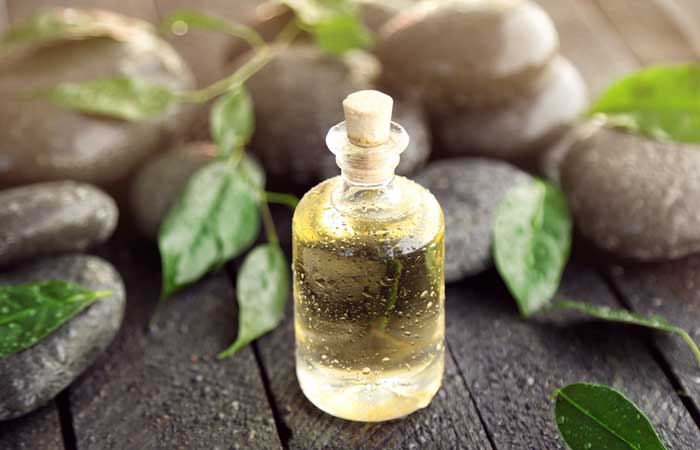
You Will Need
Tea tree oil
What You Have To Do
- Take some tea tree oil in your palms and massage it onto the areas affected by spider veins.
- You can also add aloe vera or any other carrier oil for the massage.
How Often You Should Do This
Do this daily.
Why This Works
Tea tree oil has antibacterial and antiseptic properties. Thus, it can be used for treating spider veins and relieving the inflammation and discomfort associated with them.
Tip
Tea tree oil, when combined with aloe vera, can also moderately treat spider veins.
Back To TOC
17. Saline Injections
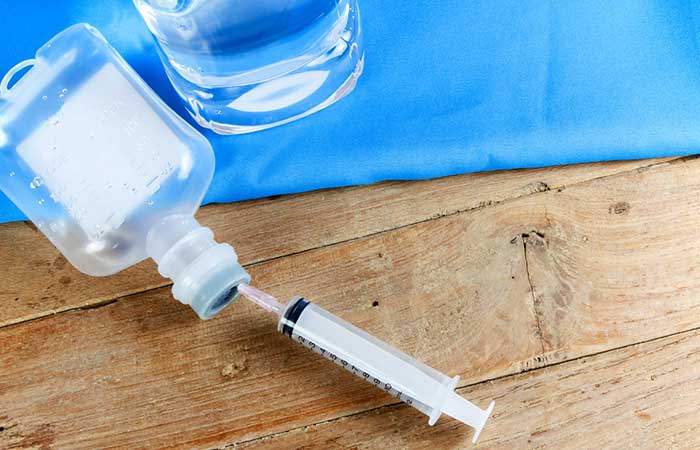
You Will Need
Saline injections (Sclerotherapy)
What You Have To Do
- This process mainly involves injecting a saline solution into the affected veins.
- At times, this step is followed by compressing the injected area with bandages or stockings.
How Often You Should Do This
As suggested by your physician.
Why This Works
Saline injections, also referred to as sclerotherapy, have been used for treating spider veins for centuries. Injecting a saline solution into the affected veins results in the damage of the inner vein walls. This leads to inflammation and clotting of blood in the veins, and the spider veins lose their color and diminish in appearance (14).
Caution
Take these injections only under medical supervision.
Back To TOC
18. Turmeric
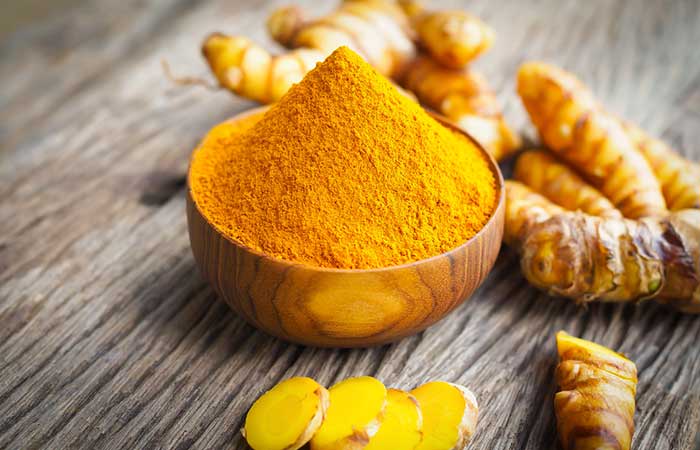
You Will Need
- 1 teaspoon of turmeric powder
- 1 glass of milk
What You Have To Do
Add a teaspoon of turmeric to a glass of hot milk and consume daily.
How Often You Should Do This
Drink this daily for best results.
Why This Works
Turmeric contains a phytochemical called curcumin, which is rich in antioxidants and imparts anti-inflammatory and antiseptic properties to it. These properties help treat spider veins and relieve the symptoms.
Tip
You can also mix turmeric with water and apply it directly to the affected areas.
Back To TOC
How To Prevent Spider Veins
- Always wear a sunscreen to limit the spider veins on your face.
- Exercise daily to improve the blood circulation in your legs.
- Keep a check on your weight.
- Eat healthily. Foods like fruits, onions, and garlic are rich in flavanoids that reduce blood pressure and relax the blood vessels.
- Do not sit for long durations.
- Avoid wearing tight clothing.
- Wear support stockings.
- Avoid wearing high heels for a long duration.
- Follow a low-salt, high-fiber diet and consume foods like oats, wheat, flaxseed, whole grains, nuts, and seeds.
- Keep the leg elevated to reduce pressure in the leg veins. Gravity will enable smooth blood flow to the heart.
- Gently massage the affected area to help blood circulation.
If you follow the above tips and remedies discussed in this post, you will see your spider veins vanish in no time.
Hope this article helped address all your doubts and queries related to spider veins. For more information, do not hesitate to get in touch with us through the comments section below.
Back To TOC
Frequently Asked Questions
Can spider veins go away on their own?
No, spider veins do not heal without treatment.
What can happen if spider veins are not treated?
If left untreated, spider veins may start to swell and pain. The symptoms can also become worse if not attended to immediately (15).
What happens if you pop a spider vein?
Under medical supervision, a spider vein may be popped by a needle. However, if a spider veins pops due to an injury, apply an ice compress to the affected area immediately to avoid further bleeding.
Can spider veins cause swollen ankles?
If spider veins are present inside the ankle, there is a possibility of a more serious underlying condition. In this case, swelling and inflammation of the ankles are quite common and need to be treated immediately (16).
Can you tattoo over spider veins?
Tattooing over spider veins is usually done to hide their appearance. However, this increases the risk of vein damage and infection in that area (17).
Are compression stockings good for spider veins?
Yes, compression stockings are good for spider veins and help relieve the symptoms associated with it. They are especially helpful for those who need to sit for a long time as they promote blood flow (18).
Recommended Articles:
- How To Use Apple Cider Vinegar For Spider Veins
- 7 Effective Asanas To Treat Varicose Veins
- 5 Simple Makeup Tips To Cover Varicose Veins/Spider Veins
- 7 Effective Home Remedies To Treat Interstitial Cystitis
Was this article helpful?
The following two tabs change content below.
- Author
- Reviewer

Shaheen holds a postgraduate degree in Human Genetics and Molecular Biology. She is a Geneticist with proficiency in Biotechnology, Immunology,... more

Dr. Bhakti Kapse is a General Practitioner with over 10 years of experience in family medicine. She obtained her Bachelor... more
How To Get Rid Of Spider Veins Naturally
Source: https://www.stylecraze.com/articles/how-to-get-rid-of-spider-veins-naturally/
Posted by: hardinaporged.blogspot.com

0 Response to "How To Get Rid Of Spider Veins Naturally"
Post a Comment